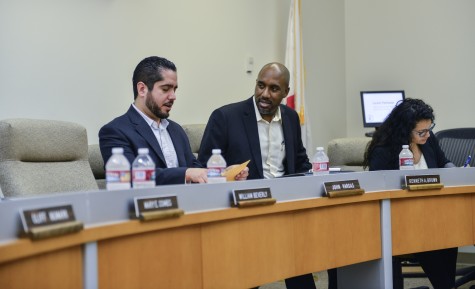The race to racial representation
April 24, 2015
The opponent was ahead; he had a slight lead. Then the results flipped. Then they flipped again. The gap kept narrowing and then widening. The score was unpredictable up until the very last minute.
But this was no basketball game or soccer scrimmage.
It was the Nov. 5, 2013 election for El Camino’s Board of Trustees, in which newcomer John Vargas was running against incumbent and current Hawthorne City Councilman Nilo Michelin.
“Oh my God, it was intense,” Vargas said. “The polls closed at eight o’clock, and we were calling people until about seven-fifty, calling to make sure they voted.”
At 8 p.m., Vargas took a deep breath, put down the phone, and began the waiting game.
“I couldn’t talk to anyone on my campaign team because I was so anxious,” he said. “I kept hitting the refresh button on the website every other minute. It was a really close election.”
When I finally got home that night, it hit me: I won.
— John Vargas
How close? One hundred and forty-three votes and a 2.92 percent margin, according to the Los Angeles County Department of Registrar-Recorder/County Clerk. Vargas remembers when the final numbers came in.
“When I first got the phone call, I was actually just relieved it was over,” Vargas said. “But then when I finally got home that night, it hit me: I won.”
Vargas’ win was sweetened by the fact that it was shared with his older brother, Alex Vargas, who simultaneously ran and won the election for Hawthorne City Council that night.
“That was the special part,” Vargas said. “In 2011, I had run for city council and him for mayor — and we both lost. I knew our win this time wasn’t guaranteed, and it would be tough. But I thought it was worth a try.”
Vargas’ success signified more than just a tangible culmination in his hard work in education administration. It was also the beginning of a new life chapter and a historic shift in representation for local government in the South Bay; he became the first ever Latin American representative to hold a position on the board of trustees at El Camino.
Since El Camino’s inception in 1947, it has been deemed as a primarily Hispanic-serving institution, with Hispanic and Latin American students representing the largest demographic of the student body in recent years.
According to El Camino’s Annual Fact Book, from the years of 2008-2013, Hispanics averaged about 40 percent of enrolled students, with whites at about 20 percent, African Americans at about 20 percent, and Asians at about 15 percent. Yet until Vargas’ win, there was no racial representation of this fact in El Camino’s board of trustees.
“It’s so important for the board to have a variety of representation that is reflective of the community it serves,” Vargas said. “I don’t just represent the student population on campus, but I also represent the surrounding community as well.”
And representation was a key factor that contributed to Vargas’ win. According to the El Camino College Administration News website, on Feb. 28, 2012, the board of trustees voted in a 4-1 decision to change the trustee boundaries in the El Camino Community College District that had been in place for 60 years. Citizens now only vote for candidates in their own areas instead of all candidates at large, which means that a Redondo Beach citizen has no say in who represents Inglewood.

Vargas, left, speaks with fellow trustee member Ken Brown at the board of trustee meeting on Feb. 17 at El Camino.
The change also redrew the district lines so that they were equally distributed; each area now has an average of 108,000 people per district, whereas before, the district numbers varied from approximately 15,000 to 157,000
Prior to serving El Camino, Vargas had been serving the Hawthorne School District as Vice President of the Board of Trustees, which meant he had specific experience in serving the needs of that geographic area, and in serving in elected education administration. His current trustee position represents Area 2 of the El Camino Community College District, which encompasses Hawthorne High, Leuzinger High and Lawndale High.
But even more critical to his success than his geographic location, Vargas said, are his cultural heritage and upbringing.
“I was raised in a close-knit Mexican-American household, with my mom, dad, and three older siblings,” Vargas said. “I had a lot of support from my immediate family. My dad always pushed us and supported us to do well in school. He did whatever he needed to do in order to make sure we were successful.”
After graduating from the California Math and Science Academy in Carson, Vargas entered the University of California, Los Angeles as a physics major, following in the footsteps of his siblings, who all had pursued science related degrees. But after his first year, Vargas came to a conclusion.
“I didn’t like physics,” he said. “At all.”
His entire life, Vargas said his father was an active follower of current events, and often discussed politics, Mexican history, and American history with him. Vargas said he always had found those discussions intriguing; he switched to major in political science.
Soon after graduating from UCLA, he discovered his interest in education.
“I found inspiration in my older brother, Gerard, who was working at the time as Curriculum Specialist for Green Dot Public Schools in Los Angeles,” Vargas said. “In 2007, I founded a charter school of my own, the Global Education Academy in South Los Angeles.”
Like any newcomer to a field, Vargas’ most significant challenge at the beginning of his career in education administration was his lack of experience.
“People would say, ‘You’re so young. How can you have started a charter school at only 27 years old?’” Vargas said. “It intimidated me a bit at first, but it ultimately pushed me to prove to people that I had the skills necessary to do my job.”
His current job is “prioritizing El Camino students and how I can best serve them,” Vargas said.
Reflecting on his first year in office, Vargas explained that he had been advocating for the continuation and expansion of programs including First Year Experience and the Puente Project at El Camino.
The Puente Project is a unique nationwide program whose goal, according to its website, is “to increase the number of Mexican American/Latino students and educationally underserved students who enroll in four-year colleges and universities, earn degrees, and return to the community as leaders and mentors to future generations.”
Programs like Puente are especially key, Vargas said, just as “my identity as a Mexican American is important to me – it impacts how I view policies, especially when looking at all the different socioeconomic factors in the community.”
A core tenant of the Puente Project is providing more students access to a quality education, which is a value that Vargas strives for.

“Education is the most important tool society can use in terms of improvement,” Vargas said. “Not only in terms of wealth, but in safety and quality of life for all residents.”
This year, he plans to focus on working with the local high school districts in order to ensure that more students are entering El Camino prepared.
“I want to make sure students are utilizing dual enrollment programs while students are still in high school, and are not having to take remedial classes,” Vargas said.
For high school students or current El Camino students who might be interested in pursuing a career in political science, education, or administration, “It all starts here,” Vargas said.
“You have to get involved, get experience and put yourself out there,” he said.
He recommends students attend city council meetings, volunteer for local campaigns, or follow the agendas of the monthly board of trustee meetings.
“My position at El Camino was a full circle opportunity to give back to a place I was born and raised in. And in my experience,” Vargas added, “the only way to get support within your community is to support them yourself.”

